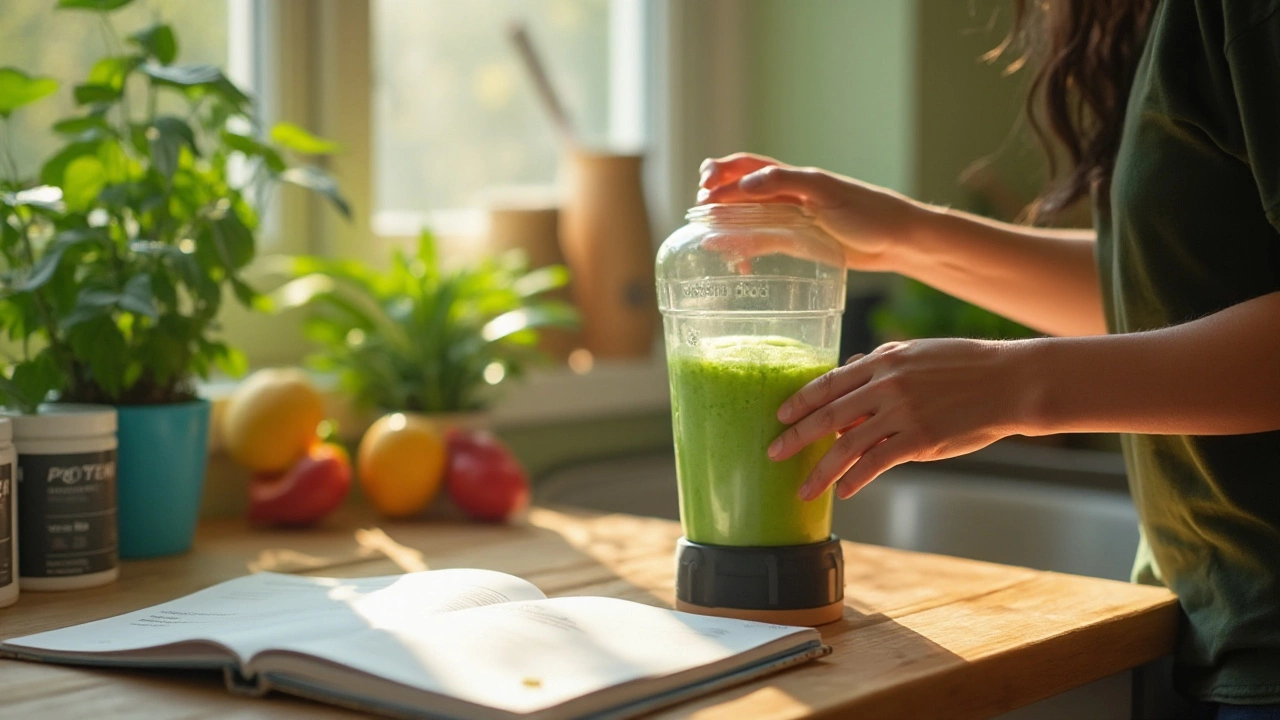
When it comes to losing a few pounds quickly, many people turn to the simplicity and effectiveness of protein shakes. These tasty, easy-to-prepare drinks can do much more than just help with weight loss. They can boost energy, preserve muscle mass, and even keep hunger at bay. But the magic happens only when you know how to use them properly in your diet.
In the next few sections, let's delve into the world of protein shakes, covering everything from selecting the perfect shake to finding creative ways to make them a delicious part of your daily routine. Whether you are new to this or have some experience, you'll find valuable tips and information that could make a difference in your weeklong weight loss journey.
Protein shakes are more than just a passing trend; they have become a staple for many seeking effective weight management and muscle maintenance. It all starts with understanding their basic composition and purpose. These shakes are primarily designed to provide a concentrated source of protein, which is essential for maintaining muscle mass, especially when calorie intake is reduced. The types of protein commonly found in shakes include whey, casein, soy, and pea. Each of these options has its benefits and characteristics, which can align with varying dietary preferences and goals. Whey protein, for instance, is well-known for its quick absorption and benefits in muscle recovery.
For those looking at long-term benefits, protein shakes serve as a meal or snack replacement, fitting seamlessly into busy routines without compromising nutritional needs. Their adaptability ensures convenience, but their role in weight loss stems from their ability to increase satiety. A well-timed shake can tide over hunger pangs and regulate portion control during main meals. Protein shakes also encourage the body to burn more calories due to the thermic effect of food, which means the body uses energy to digest, absorb, and metabolize nutrients. This can support weight loss goals effortlessly.
While some might worry about artificial ingredients, many protein shakes now come packed with added vitamins, minerals, and even fiber, making them a wholesome addition to any diet plan. According to Mark Hyman, MD, a well-known physician and health advocate, "Protein is the most important macronutrient for every cell in the body. Besides weight loss, it aids in building brain chemicals, hormones, and enzymes." Reflecting on this point, it's no wonder that protein shakes have earned their place in both casual and athlete diets. To choose wisely, understanding the labels is key. Those aiming for weight loss should opt for low-sugar and low-calorie options, prioritizing natural sweeteners like stevia or monk fruit.
For anyone skeptical or new, trial and error play a part—trying different types of protein and flavors can lead to the perfect fit for taste and dietary needs. It's also worth noting that protein needs vary based on activity levels, age, and dietary restrictions. While the general recommendation is around 46-56 grams per day for the average adult, those engaged in intense training might require more. Balancing these shakes within a broader nutrition strategy is critical as they should complement rather than replace the bounty of benefits found in whole foods.
Deciding on the perfect protein shake can be a bit overwhelming with so many options on the market, but it's essential to find one that fits your dietary needs and helps you meet your weight loss goals. The first thing to consider is the protein source. Common options include whey, soy, and pea protein, all of which offer different benefits. Whey protein is a favorite because it contains all the essential amino acids and is easily absorbed by the body, making it an excellent choice for muscle recovery and fat loss. Soy protein is suitable for those who prefer a plant-based diet, providing a similar protein punch but without any animal products. Pea protein is another plant-based option that's hypoallergenic, which is perfect for those with dairy sensitivities.
Another factor is the caloric content of the shake. If you're aiming to lose weight, you should select shakes with lower calories per serving, ideally below 200, especially if it's replacing a meal. Remember that while a protein shake can be a helpful tool, excessively high-calorie options can defeat the purpose of your diet. Check the sugar content too, as some shakes sneak in quite a bit, which might not be in your best interest. Opt for a product with less than 5 grams of sugar per serving.
Pay attention to additional nutrients that may enhance your shake’s effectiveness. Some shakes include added vitamins and minerals like calcium and Vitamin D, which are beneficial for bone health, while others might be enriched with fiber to help you feel full for a longer time. Fiber is instrumental in digestion and turning a protein shake from mere sustenance into a filling meal replacement. Some shakes even include probiotics, which can aid in maintaining gut health during your diet.
According to a study featured in the American Journal of Clinical Nutrition, "Including protein in meals can significantly increase energy expenditure," which highlights the energy-boosting benefits of protein shakes beyond just weight loss.Ultimately, flavor matters just as much. It doesn’t matter how effective a shake might be if you can’t bear drinking it. Taste-test a few to find the ones you enjoy. Many brands offer samples or smaller sizes. Add things like frozen fruits, a spoon of nut butter, or a sprinkle of cinnamon to enhance taste without adding too many calories.
To help you decide quickly, here's a simple comparison:
| Protein Source | Best For | Common Additives |
|---|---|---|
| Whey | Muscle recovery, fat burning | Amino acids, calcium |
| Soy | Plant-based diets | Vitamins B12, D |
| Pea | Hypoallergenic needs | Iron, antioxidants |
By following these tips, you can choose a protein shake that not only aligns with your dietary preferences but also powerfully supports your weight loss journey. Factor in your goals, what nutrients you need, and what flavors you enjoy to ensure a pleasant, rewarding experience every time you reach for your shaker bottle.

Adding protein shakes to your daily eating plan might sound simple, but it requires a thoughtful approach to ensure effectiveness. The key to using shakes for weight loss isn't just about replacing meals. It's about integrating them in such a way that they complement your diet and lifestyle. First, consider when you're most likely to need a quick yet nutritious meal — is it breakfast when you're rushing out the door, after a workout when your muscles crave nutrients, or late in the evening when cravings hit?
Whichever time it might be, protein shakes can be your go-to option, providing convenience and nutrition. For breakfast, a shake packed with fruits and a scoop of plant-based or whey protein can offer a powerful start to your day. Post-workout, a light shake with almond milk and a scoop of protein can aid in recovery, while a simple, low-calorie shake in the evening can help curb cravings without derailing your diet. Keep in mind that striking a balance is essential, so ensure your meals are still well-rounded and include fresh fruits, vegetables, lean proteins, and whole grains.
"A practical approach to using protein shakes effectively involves timing them around your most hectic periods. This not only sustains energy levels but also supports weight goals," Dr. Jane Mitchell, a nutrition expert, advises.
One effective method for incorporating shakes is to replace just one meal a day with a blend that fits your taste preferences. This keeps meals exciting and prevents falling into a monotonous routine. Placing importance on variety is crucial because it maintains your interest and satisfaction levels. Keep experimenting with different ingredients, like adding spinach for extra nutrients or peanut butter for additional flavor. Strive for a balance of protein, carbohydrates, and healthy fats in your shakes, ensuring they keep you satiated until your next meal.
Moreover, portion control is essential. While shakes are powerful, it's easy to overconsume them if not careful. The nutritional label isn't just for your curiosity; it's a tool to track your intake. Always measure your servings of powder, particularly if you're making a shake at home. If buying ready-made versions, familiarize yourself with the calorie content. An ideal shake for weight loss should be between 200 and 400 calories, with at least 20 grams of protein.
| Meal | Suggested Time | Calories | Protein (grams) |
|---|---|---|---|
| Breakfast | 7 AM - 9 AM | 300 | 25 |
| Post-Workout | 11 AM - 1 PM | 200 | 20 |
| Evening | 7 PM - 9 PM | 350 | 30 |
When it comes to making your protein shakes a delightful part of your routine, variety and taste are key. While these shakes are known for their convenient weight loss benefits, keeping your taste buds happy is equally important. The first step is to experiment with different base liquids, such as almond milk, coconut water, or even brewed green tea. Each can bring a unique flavor profile and texture to your shake, making every sip a new experience.
Adding fruits is another exciting way to enhance the taste. Popular choices include bananas, which add creaminess, or berries for a burst of tang and sweetness. If you're feeling adventurous, try tropical options like mango or pineapple to transport your senses somewhere warm and sunny. Don't shy away from spices and flavorings, either. A dash of cinnamon or a splash of vanilla extract can elevate your shake, transforming it from a mere meal supplement to a gourmet treat.
For those who are health-conscious or have busy mornings, considering the nutritional aspect of your added ingredients is essential. Leafy greens such as spinach or kale can increase the fiber content of your shake without altering its taste too much. They blend easily and are an excellent way to sneak some extra vitamins into your day. A tablespoon of chia or flax seeds can add nutritional value as well as texture to your mix. These powerhouse ingredients are packed with Omega-3 fatty acids and provide a subtle nutty flavor.
Occasionally, a little creativity can go a long way. Using natural sweeteners like honey or maple syrup can amp up sweetness levels without resorting to artificial options. Moreover, adding a spoonful of nut butter, such as almond or peanut, can enhance the richness of your protein shake and make it more filling. This is particularly helpful if you're aiming to replace a full meal with your shake while ensuring satisfaction and longevity in your energy levels.
Even when enhancing variety, it’s crucial to keep track of the calorie content of these ingredients. While it’s easy to get carried away, maintaining balance ensures you stay on track with your weight loss goals. Keep a mental note or, better yet, jot down the additions. This way, you’re always in the know about what you’re consuming. Many people find it helpful to pre-portion some ingredients to make mornings organized and seamless.
"Adding a variety of flavors to your shakes can keep your motivation high and prevent taste fatigue," suggests nutrition expert Samantha Reed. "The key is to use natural, healthy ingredients to enhance both flavor and nutritional value."
Finally, if you enjoy a bit of crunch, topping your shake with granola or a sprinkle of cacao nibs can provide a delightful textural contrast. It’s also a great way to avoid consuming extra snacks later. In short, keep experimenting with different ingredients and combinations. It’ll make your weight loss journey with protein shakes as tasty as it is effective.

Achieving a swift reduction of 5 pounds in a week with the aid of protein shakes is not only plausible but can also lay the groundwork for sustainable weight loss. To retain the progress you've made, it's vital to blend these shakes with lifelong healthy habits. Understanding how different factors can contribute to or hinder your goals is crucial for keeping those pounds from sneaking back.
"The only bad workout is the one that didn’t happen." – Fitness Industry Saying